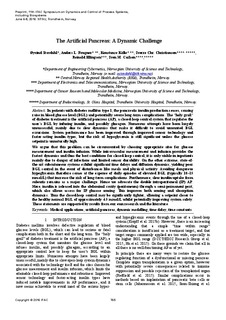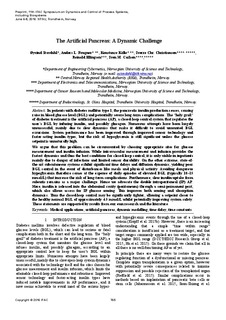| dc.contributor.author | Stavdahl, Øyvind | |
| dc.contributor.author | Fougner, Anders Lyngvi | |
| dc.contributor.author | Kölle, Konstanze | |
| dc.contributor.author | Christiansen, Sverre Christian | |
| dc.contributor.author | Ellingsen, Reinold | |
| dc.contributor.author | Carlsen, Sven Magnus | |
| dc.date.accessioned | 2016-06-08T08:15:50Z | |
| dc.date.accessioned | 2016-06-21T09:09:27Z | |
| dc.date.available | 2016-06-08T08:15:50Z | |
| dc.date.available | 2016-06-21T09:09:27Z | |
| dc.date.issued | 2016 | |
| dc.identifier.citation | IFAC-PapersOnLine 2016:765-772 | nb_NO |
| dc.identifier.issn | 2405-8963 | |
| dc.identifier.uri | http://hdl.handle.net/11250/2393367 | |
| dc.description.abstract | In patients with diabetes mellitus type 1, the pancreatic insulin production ceases, causing raise in blood glucose level (BGL) and potentially severe long-term complications. The “holy grail” of diabetes treatment is the artificial pancreas (AP), a closed-loop control system that regulates the user’s BGL by infusing insulin, and possibly glucagon. Numerous attempts have been largely unsuccessful, mainly due to slow dynamics that make it difficult to avoid unwanted BGL excursions. System performance has been improved through improved sensor technology and faster-acting insulin types, but the risk of hypoglycemia is still significant unless the glucose setpoint is unnaturally high. We argue that this problem can be circumvented by choosing appropriate sites for glucose measurement and insulin infusion. While intravascular measurement and infusion provides the fastest dynamics and thus the best conditions for closed-loop control, it is only viable in inpatients mainly due to danger of infections and limited sensor durability. On the other extreme, state-of-the-art subcutaneous systems exhibit significant time delays and diffusion dynamics, yielding poor BGL control in the event of disturbances like meals and physical activity. Avoiding dangerous hypoglycemia therefore comes at the expense of daily episodes of elevated BGL (typically 10–15 mmol/L) that increase the risk of long-term complications. Furthermore, slow insulin uptake from subcutis remains as a major challenge. Hence we advocate the double intraperitoneal (IP) AP. Here, insulin is released into the abdominal cavity (peritoneum) through a semi-permanent port, which also allows access for IP glucose sensing. This improves both sensing and absorption dynamics. Thus the closed-loop control may be significantly tighter, allowing a setpoint closer to the healthy normal BGL of approximately 4.5 mmol/L whilst potentially improving system safety. These statements are supported by results from our own research and the literature. | nb_NO |
| dc.language.iso | eng | nb_NO |
| dc.publisher | Elsevier | nb_NO |
| dc.title | The Artificial Pancreas: A Dynamic Challenge | nb_NO |
| dc.type | Journal article | nb_NO |
| dc.type | Peer reviewed | nb_NO |
| dc.date.updated | 2016-06-08T08:15:50Z | |
| dc.subject.nsi | VDP::Teknologi: 500::Medisinsk teknologi: 620 | nb_NO |
| dc.subject.nsi | VDP::Technology: 500::Medical technology: 620 | nb_NO |
| dc.subject.nsi | VDP::Teknologi: 500::Informasjons- og kommunikasjonsteknologi: 550::Teknisk kybernetikk: 553 | nb_NO |
| dc.subject.nsi | VDP::Technology: 500::Information and communication technology: 550::Technical cybernetics: 553 | nb_NO |
| dc.source.pagenumber | 765-772 | nb_NO |
| dc.source.journal | IFAC-PapersOnLine | nb_NO |
| dc.identifier.cristin | 1360124 | |
| dc.description.localcode | © 2016 IFAC. | nb_NO |

